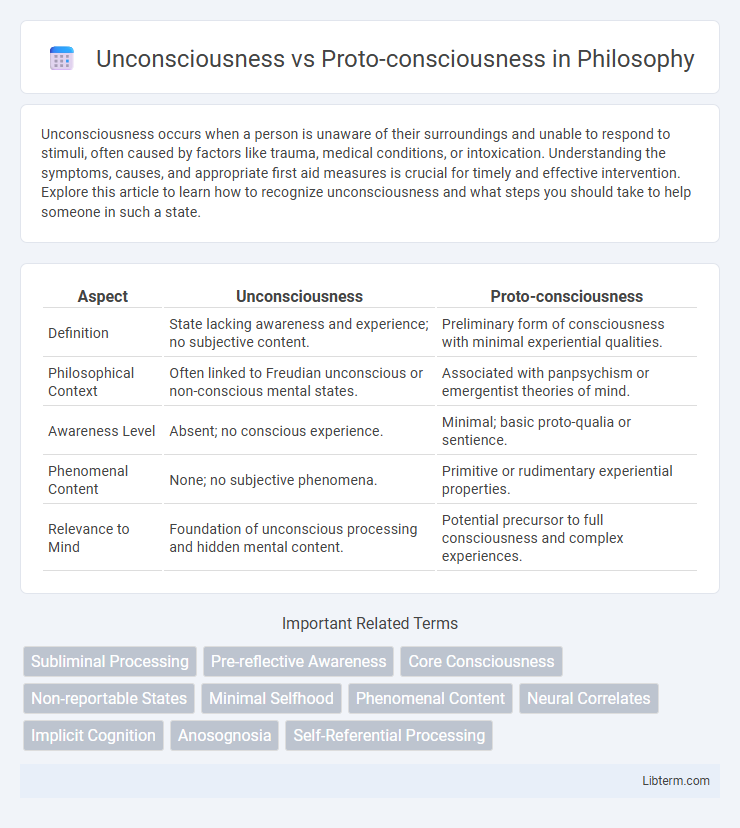Unconsciousness occurs when a person is unaware of their surroundings and unable to respond to stimuli, often caused by factors like trauma, medical conditions, or intoxication. Understanding the symptoms, causes, and appropriate first aid measures is crucial for timely and effective intervention. Explore this article to learn how to recognize unconsciousness and what steps you should take to help someone in such a state.
Table of Comparison
| Aspect | Unconsciousness | Proto-consciousness |
|---|---|---|
| Definition | State lacking awareness and experience; no subjective content. | Preliminary form of consciousness with minimal experiential qualities. |
| Philosophical Context | Often linked to Freudian unconscious or non-conscious mental states. | Associated with panpsychism or emergentist theories of mind. |
| Awareness Level | Absent; no conscious experience. | Minimal; basic proto-qualia or sentience. |
| Phenomenal Content | None; no subjective phenomena. | Primitive or rudimentary experiential properties. |
| Relevance to Mind | Foundation of unconscious processing and hidden mental content. | Potential precursor to full consciousness and complex experiences. |
Defining Unconsciousness and Proto-consciousness
Unconsciousness refers to a state where an individual lacks awareness and responsiveness to external stimuli, often characterized by a complete absence of conscious experience and cognitive function. Proto-consciousness denotes a foundational or pre-conscious state featuring rudimentary awareness or minimal experiential quality, suggesting a basic form of sentience without fully developed consciousness. Distinguishing unconsciousness from proto-consciousness involves analyzing neurological activity patterns and levels of awareness, with proto-consciousness implying potential for conscious experience while unconsciousness implies a total lack thereof.
Historical Perspectives on Consciousness
Early philosophical views, like those of Aristotle and Descartes, framed consciousness as a distinct, active faculty of the mind, while unconscious processes remained largely unexplored. In the 19th and 20th centuries, figures such as Freud introduced the unconscious as a dynamic realm influencing behavior beneath awareness, contrasting with emerging concepts of proto-consciousness as a primitive, pre-reflective state. Contemporary historical analyses trace this evolution, highlighting shifts from dualistic separations toward integrated models that recognize varying degrees of conscious experience and unconscious processing.
Key Differences Between Unconsciousness and Proto-consciousness
Unconsciousness refers to a state where awareness and responsiveness to the environment are entirely absent, often observed during deep sleep, anesthesia, or coma. Proto-consciousness, in contrast, implies a foundational level of awareness or pre-conscious experience, suggesting rudimentary cognitive processes that precede full consciousness. Key differences include the presence of minimal subjective experience in proto-consciousness versus the complete lack of awareness in unconsciousness, alongside differing neural correlates where proto-consciousness involves early brain activity patterns indicative of basic perceptual or cognitive functions.
Neurological Basis of Unconsciousness
The neurological basis of unconsciousness involves disrupted brain activity in key areas such as the thalamus, brainstem, and cortex, which impede the integration of sensory information and cortical communication. In contrast, proto-consciousness refers to basic neural processes that reflect a foundational level of awareness or sentience without full conscious experience, often linked to minimal thalamocortical activity or early neural networks. Understanding these distinctions relies heavily on studies of EEG patterns, neuronal firing rates, and functional connectivity that delineate unconscious states from proto-conscious states.
Brain Mechanisms Underpinning Proto-consciousness
Proto-consciousness is linked to specific brain mechanisms involving neural oscillations and thalamocortical interactions that support rudimentary awareness prior to full conscious experience. Subcortical structures like the brainstem and intralaminar nuclei play a crucial role in modulating arousal and integrating sensory inputs, forming the neural substrate for proto-conscious states. These mechanisms contrast with unconsciousness, where widespread neural connectivity and thalamic-cortical loop disruptions result in a lack of experiential content.
Levels and States of Conscious Awareness
Unconsciousness involves a complete lack of awareness and responsiveness, typically observed in deep sleep, coma, or anesthesia, where brain activity shows minimal or no conscious processing. Proto-consciousness represents a basic, pre-reflective level of awareness found in early brain development or altered states, characterized by minimal but foundational sensory and experiential integration. Different levels and states of conscious awareness range from full wakefulness and self-reflective consciousness to proto-conscious and unconscious states, each defined by varying neural correlates and cognitive capacities.
Evolutionary Origins of Proto-consciousness
Proto-consciousness likely emerged during early evolutionary stages as a primitive form of awareness, providing organisms with adaptive advantages in processing environmental stimuli. This nascent state of consciousness enabled faster reactions and improved survival by integrating sensory information without full self-awareness or reflective thought. Fossil records and comparative neurobiology suggest proto-consciousness evolved in simple neural networks of ancient organisms, laying the groundwork for complex conscious experiences in higher species.
Clinical Implications: Disorders of Consciousness
Disorders of consciousness, including coma, vegetative state, and minimally conscious state, challenge clinical assessments by differentiating unconsciousness from proto-consciousness. Proto-consciousness involves minimal awareness and potential for recovery, influencing treatment strategies such as sensory stimulation and pharmacological interventions. Accurate diagnosis using neuroimaging and electrophysiological tools enhances prognosis and guides therapeutic decisions for patients with impaired consciousness.
Measuring and Detecting Proto-conscious States
Measuring proto-conscious states involves detecting minimal forms of awareness through neurophysiological markers such as synchronized neural oscillations and patterns of cortical connectivity that differ from deep unconsciousness. Advanced techniques like functional MRI, EEG coherence, and complexity metrics such as neural entropy are critical in distinguishing proto-conscious activity from unconscious brain states. Identifying these subtle neural signatures enables researchers to map the gradient between unconsciousness and proto-consciousness in clinical and experimental settings.
Future Research Directions in Consciousness Studies
Future research in consciousness studies aims to clarify the distinctions and interactions between unconsciousness and proto-consciousness through advanced neuroimaging techniques and computational modeling. Investigations will emphasize identifying neural correlates that bridge minimal awareness states and fully unconscious processes, potentially revealing new layers of cognitive function. Integrating interdisciplinary approaches from neuroscience, psychology, and philosophy could accelerate understanding proto-consciousness as a foundational stage in the emergence of subjective experience.
Unconsciousness Infographic

 libterm.com
libterm.com